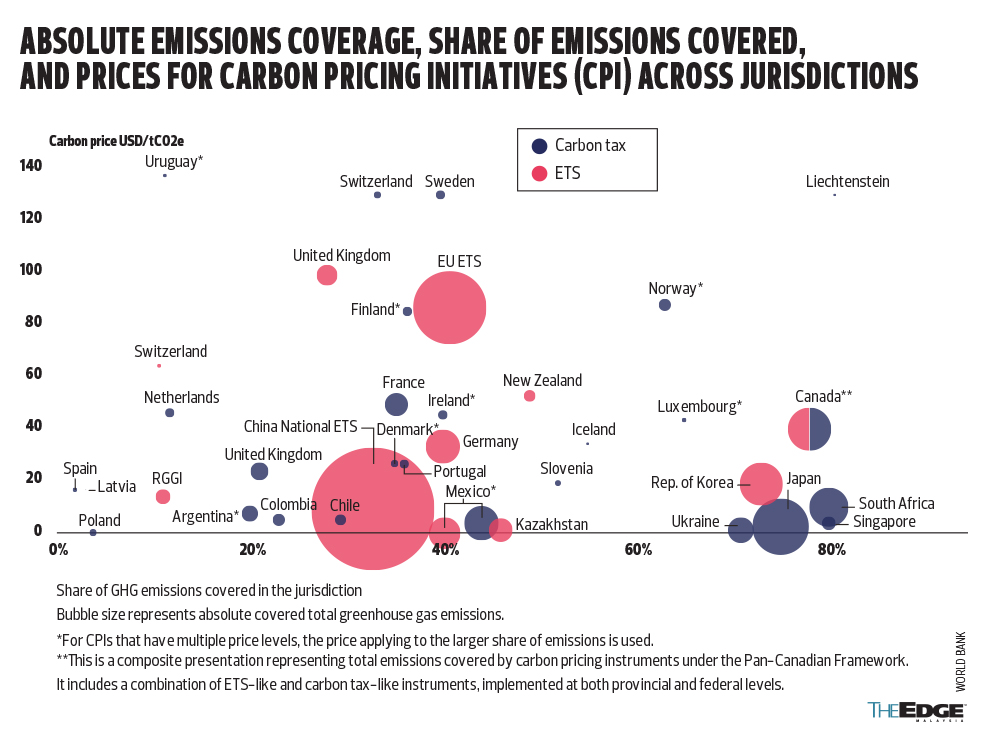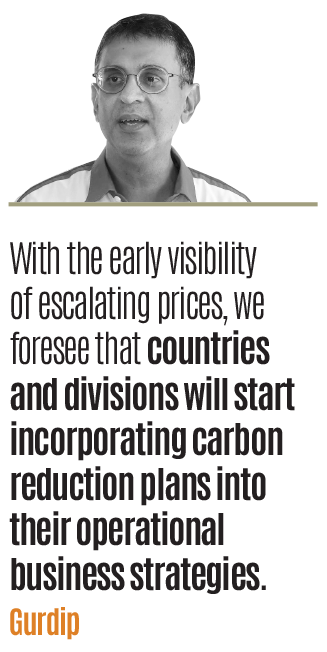
This article first appeared in The Edge Malaysia Weekly on October 17, 2022 - October 23, 2022
By now, many Malaysian companies would have been warned about the impending impact of carbon taxes on their operations, especially if they are exporters to the European Union (EU).
The EU’s Carbon Border Adjustment Mechanism (CBAM), which is expected to kick in gradually from 2023, will impose a carbon price on non-EU producers. Basically, EU importers will buy carbon certificates corresponding to the price they would have paid if the goods were covered under the EU’s carbon pricing rules. This cost is then charged to non-EU producers.
But if the non-EU producer can show that it already paid a price for the carbon used in the production of the imported goods — like a carbon tax — in another country, then the corresponding cost for the EU importer can be cancelled.
This is to level the playing field for EU companies, which have to comply with the EU’s carbon pricing and prevent “carbon leakage”, where companies move their operations to countries that do not have carbon pricing mechanisms.
The EU is Malaysia’s third-largest trading partner. In 2020, imports to the EU were at €24.7 billion, according to the delegation of the EU to Malaysia. A 2021 report by the Commonwealth Secretariat highlighted that Malaysia had US$769 million worth of CBAM-related exports to the EU in 2019.
Obviously, Malaysian businesses will be impacted by the CBAM. This impact could be lessened if Malaysia has its own carbon pricing mechanisms. In fact, carbon taxes have been tabled in the proposal of the 12th Malaysia Plan, and the cabinet has agreed to develop a domestic emissions trading scheme (ETS) in phases.
Either way, Malaysian businesses may have to face a carbon tax or be subject to an ETS, which caps the amount of greenhouse gas (GHG) they can emit, in the future. The question is how these carbon pricing mechanisms will affect businesses and consumers. Some businesses have already begun implementing internal carbon prices (see sidebar) to prepare for this reality.
“Since Malaysia is very connected to other countries by exporting fossil fuels and supplying various goods and products, whatever is happening at the global level will impact the country. The businesses that have started to look at carbon pricing are those that either have international value chains or investors,” says Yulia Dobrolyubova, partner of corporate sustainability and climate change at consultancy firm Environmental Resources Management (ERM).
Even though most of the carbon pricing mechanisms imposed by other countries will not impact Malaysian companies directly, like the CBAM, the pressure will be felt throughout the supply chain.
“Companies that are subject to the carbon tax would need to decarbonise their value chains. If their indirect Scope 3 emissions come from a Malaysian supplier, they will look for suppliers in other markets that are less carbon-intensive. That’s the indirect impact of carbon taxes,” says Dobrolyubova.
Globally, there are 68 carbon pricing instruments in operation, according to the World Bank’s State and Trends of Carbon Pricing 2022 report. These cover around 23% of total GHG emissions. This number is likely to increase as carbon pricing is seen as an important policy tool to encourage businesses to decarbonise and incentivise the adoption of low-carbon technologies.
Under a carbon pricing regime, companies pay a carbon tax or purchase emission allowances from an ETS to continue emitting GHG. Alternatively, they could invest in low-carbon solutions to reduce their emissions. If the carbon price is higher than the cost of acquiring solar power panels or an energy-efficient chiller, for instance, companies would be incentivised to go for the latter solutions.
In contrast, “hydrogen is still quite expensive today. If the carbon price is lower than the cost of switching to hydrogen, companies will still prefer to pay the tax. [A carbon tax] will encourage companies to implement [low-carbon] technologies that are cheaper than paying the tax on carbon”, says Darshan Joshi, climate consultant at the Asia Foundation.
Pricing carbon will send a signal to market players that carbon emissions come with a cost, Joshi adds. It results in climate change impacts such as flooding, lower agriculture yields and spread of communicable diseases. It is also a key policy tool for governments to collect funds and invest in low-carbon solutions.
“Since 2009, we have spent an enormous amount of money [to incentivise the take-up of green solutions]. We have our feed-in-tariff (FiT), net energy metering (NEM), green investment tax allowance and so on to boost RE [renewable energy] take-up. Many are incentive- or subsidy-based. In the end, around 95% of our electricity generation still comes from fossil fuels. The impact hasn’t quite been there,” says Joshi.
“Carbon pricing is a different avenue to achieve the same goal. It might be even more effective. Once we address the market failure [of failing to consider the negative externalities of carbon emissions], then we can see other policies like the FiT, NEM or even a fuel economy standard for cars [become even more effective]. That’s the whole ecosystem needed on the policy side to really drive the sustainability agenda forward.”
Joshi published a study, which can be found on the Penang Institute’s website, on the possibility of implementing carbon pricing in Malaysia in 2019.
He calculated that implementing a RM35/tCO2e (tonne of carbon dioxide equivalent) carbon tax — based on the social cost of carbon emissions — in 2020 that peaks at RM150/tCO2e in 2028 would raise between RM21.8 billion and RM24.6 billion in average annual revenues for Malaysia. This is assuming that the tax is imposed on the sectors of electricity, transport, and oil and gas production.
Between 29.2% and 44.5% of the total revenue collection in the first four years can be diverted to compensate the B40, or bottom 40% income earners. The rest could be used to reduce the funding gap for climate mitigation and adaptation efforts in Malaysia.
How does it work?
There are two main types of carbon pricing mechanisms: carbon taxes and the ETS. Carbon taxes define an explicit tax rate on each tonne of GHG emitted, while ETS generally involves a cap on emissions for each sector.
Typically, these mechanisms only cover the carbon-intensive sectors. The CBAM, for instance, will initially only apply to iron and steel, cement, fertiliser, aluminium and electricity generation.
Some believe that the tax rate should be based on the social cost of carbon, which is the present value of estimated environmental damage caused over time by carbon dioxide emitted today, according to the Centre for Climate and Energy Solutions. This number is expected to rise.
However, the Carbon Pricing Leadership Coalition published a report in 2021 that highlighted how current carbon prices are too low to put the world on track for net zero by 2050. Less than 4% of global GHG emissions is covered by a carbon price needed to meet the 2°C goal of the Paris Agreement, which is between US$40/CO2 and US$80/CO2.
The International Monetary Fund (IMF) suggested in 2021 that a carbon price of US$75/CO2 is required by 2030 to keep global warming below 2°C. As at July 2022, the global average carbon price was only US$6/CO2, based on the IMF’s calculations.
The ETS, meanwhile, does not have a fixed price for carbon. The prices are determined by the market, although price floors are added in some jurisdictions to stabilise the market.
“We should be very clear that if we are going to introduce carbon pricing, every few years, it will increase by 5%, for instance. With this long-term clarity, businesses can make long-term decisions. This is different with the ETS because the prices fluctuate and it’s more complicated to do long-term financial planning,” says Joshi.
How can one assess if the carbon prices are set at the right level? Dobrolyubova suggests using the marginal abatement cost curve, which compares the cost of different GHG mitigation options.
“It looks like a waterfall chart, where some technologies’ [cost] will dip below zero, which means it’s already cost-effective now. The most effective ones in removing GHG would not be cost-effective at the moment, such as carbon capture and storage or green hydrogen,” says Dobrolyubova. “When you look at carbon pricing from this perspective, [you would know] what is needed in price reduction to make this type of technology commercially attractive in the market.”
Both interviewees suggest that carbon taxes and the ETS can exist together. Generally, a carbon tax would be suitable for sectors that use fossil fuels directly, such as the electricity sector. The ETS could be used for sectors with many players, so they can trade emission units.
A little over half of Malaysia’s emissions are from the energy sector, followed by 21% from transport, 8% from industrial process and waste respectively, and 3% from agriculture.
A carbon tax imposed on these sectors would mainly impact the big companies like Petroliam Nasional Bhd, Tenaga Nasional Bhd and large listed players. It is more difficult to do so in the transport sector, Joshi observes, since it involves individual drivers.
“The way I envision it is that we’ll have fuel economy standards to encourage car manufacturers to produce cleaner and more efficient cars. But we also have a tax borne by consumers to encourage them to drive cleaner cars and use public transport,” says Joshi. This could be an extra charge imposed at the pump, for instance.
All these, of course, will impact consumers. Joshi suggests channelling funds to compensate households in the lower socioeconomic classes.
“I think there’s a very clear awareness that a lot of work has to be done by the big emitters who really profited from the use of fossil fuels. As long as we have policies in place to compensate households, I think it’s a good workaround,” says Joshi.
There’s never a good time for taxes
Already, companies are struggling to cope with rising inflation, geopolitical instability and the post-Covid-19 recovery. Introducing a tax at this time would be unpopular and burdensome.
“But there’s always something going on. Five years ago, we had the 1MDB scandal. The government had to scrap the goods and services tax because people were struggling. In 2020, there was Covid-19. Now, there’s a war in Russia. If we keep thinking from this perspective, we’re never going to do it,” says Joshi.
“So, it’s very important that if the government implements the carbon tax, it takes some of the revenue to compensate low-income households for whatever increase in cost of living that they are going to face. I think that will largely come in the form of higher transport costs.”
This brings to the table the tricky situation of existing subsidies for fossil fuels in Malaysia. Does it make sense if the same resources are taxed and subsidised by the government?
Joshi and Dobrolyubova agree that this has to be reviewed, as it sends confusing signals.
“There’s no way we can do both. It sends very conflicting signals. My personal belief is that we need to rationalise the fossil fuel subsidy first. An analogy my colleague used was that you can’t press the accelerator and brake at the same time. The car won’t move,” says Joshi.
Setting the right price is important, so it does not put an excessive burden on businesses but is still able to send the right signals to the market. There must also be transparency as to where the funds will go, adds Joshi.
“I want to see that whatever revenue the government generates from carbon taxes goes into a specific pool. From there, we see a percentage going to rebates, investments and other kinds of sustainability-related measures, like improving our resilience [to climate change].”
Save by subscribing to us for your print and/or digital copy.
P/S: The Edge is also available on Apple's App Store and Android's Google Play.







